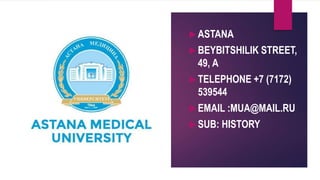
Sam11weekhistory.pptx
- 1. ASTANA BEYBITSHILIK STREET, 49, A TELEPHONE +7 (7172) 539544 EMAIL :MUA@MAIL.RU SUB: HISTORY
- 2. PLAN Anti Nuclear Movement “Nevada Semipalatinsk”
- 3. Anti nuclear Movement “Nevada Semipalatinsk” The Nevada-Semipalatinsk movement was an international anti-nuclear movement that began in 1989, in response to the Soviet Union’s atmospheric and underground nuclear testing in the Semipalatinsk region of Kazakhstan. The movement was initially formed to raise awareness and put pressure on the Soviet government to end the testing. As the movement gained momentum, it spread to other regions, including the United States, where it joined the global anti-nuclear movement. In 1991, the Soviet Union declared a moratorium on nuclear testing, and the Nevada-Semipalatinsk movement declared victory. Since then, the movement has been dedicated to helping the people of Kazakhstan recover from the environmental and health impacts of the testing. The movement has also worked to ensure that the world does not forget the tragedy of Semipalatinsk, and to promote the peaceful use of nuclear energy.
- 4. The anti-nuclear movement in Kazakhstan, “Nevada Semipalatinsk”, was formed in 1989 and was one of the first major anti-nuclear movements in the former Soviet Union.[2] It was led by author Olzhas Suleimenov and attracted thousands of people to its protests and campaigns which eventually led to the closure of the nuclear test site at Semipalatinsk in north-east Kazakhstan in 1991.[3][4][5] The movement was named “Nevada Semipalatinsk” in order to show solidarity with similar movement in the west of the United States aiming to close the Nevada Test Site.[6]
- 5. The Soviet Union conducted 456 nuclear weapons tests at the Semipalatinsk Test Site, between 1949 and 1989. The United Nations believes that one million people around Semipalatinsk were exposed to radiation, and the incidence of birth defects and cancer is much higher than for the rest of the country. According to UNESCO, Nevada-Semipalatinsk played a positive role in promoting public understanding of "the necessity to fight against nuclear threats".The movement gained global support and, became "a real historical factor in finding solutions to global ecological problems".
- 6. Astana hosted an international conference Building a Nuclear-Weapons-Free World in August 2016. The topics of the conference included nuclear non- proliferation and disarmament and the physical protection of nuclear weapons. The main outcome of the conference was the adoption of The Astana Vision Declaration “From а Radioactive Haze to a Nuclear-Weapon-Free World.”[9] The Nevada-Semipalatinsk movement is a testament to the power of international solidarity and the ability of citizens around the world to come together and make a difference. The movement has inspired people across the globe to stand up for what is right, and to fight for a better future.
- 7. The movement is still active today, advocating for nuclear disarmament, environmental protection, and human rights. The movement also continues to support the people of Kazakhstan, who still suffer from the legacy of the Soviet Union’s nuclear testing. The Nevada-Semipalatinsk movement is an inspiring example of how the power of collective action can bring about positive change. The movement has shown that when people come together and fight for what’s right, anything is possible.
- 8. Anti Nuclear Movement " Nevada-Semipalatinsk " The Nevada-Semipalatinsk movement was an international anti-nuclear movement that began in 1989, in response to the Soviet Union’s atmospheric and underground nuclear testing in the Semipalatinsk region of Kazakhstan. The movement was initially formed to raise awareness and put pressure on the Soviet government to end the testing. As the movement gained momentum, it spread to other regions, including the United States, where it joined the global anti-nuclear movement. In 1991, the Soviet Union declared a moratorium on nuclear testing, and the Nevada-Semipalatinsk movement declared victory. Since then, the movement has been dedicated to helping the people of Kazakhstan recover from the environmental and health impacts of the testing. The movement has also worked to ensure that the world does not forget the tragedy of Semipalatinsk, and to promote the peaceful use of nuclear energy. The Nevada-Semipalatinsk movement is a testament to the power of international solidarity and the ability of citizens around the world to come together and make a difference. The movement has inspired people across the globe to stand up for what is right, and to fight for a better future. The movement is still active today, advocating for nuclear disarmament, environmental protection, and human rights. The movement also continues to support the people of Kazakhstan, who still suffer from the legacy of the Soviet Union’s nuclear testing. The Nevada- Semipalatinsk movement is an inspiring example of how the power of collective action can bring about positive change. The movement has shown that when people come together and fight for what’s right, anything is possible.